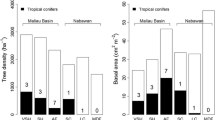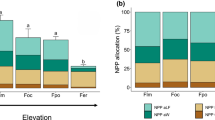Abstract
Under conditions of a warmer climate, the advance of the alpine treeline into alpine tundra has implications for carbon dynamics in mountain ecosystems. However, the above- and below-ground live biomass allocations among different vegetation types within the treeline ecotones are not well investigated. To determine the altitudinal patterns of above-/below-ground carbon allocation, we measured the root biomass and estimated the above-ground biomass (AGB) in a subalpine forest, treeline forest, alpine shrub, and alpine grassland along two elevational transects towards the alpine tundra in southeast Tibet. The AGB strongly declined with increasing elevation, which was associated with a decrease in the leaf area index and a consequent reduction in carbon gain. The fine root biomass (FRB) increased significantly more in the alpine shrub and grassland than in the treeline forest, whereas the coarse root biomass changed little with increasing altitudes, which led to a stable below-ground biomass (BGB) value across altitudes. Warm and infertile soil conditions might explain the large amount of FRB in alpine shrub and grassland. Consequently, the root to shoot biomass ratio increased sharply with altitude, which suggested a remarkable shift of biomass allocation to root systems near the alpine tundra. Our findings demonstrate contrasting changes in AGB and BGB allocations across treeline ecotones, which should be considered when estimating carbon dynamics with shifting treelines.
Similar content being viewed by others
References
Alvarez-Uria P, Körner C (2007) Low temperature limits of root growth in deciduous and evergreen temperate tree species. Functional Ecology 21(2): 211–218. DOI: 10.1111/j.1365-2435. 2007.01231.x
Balisky AC, Burton PJ (1995) Root-zone soil temperature variation associated with microsite characteristics in highelevation forest openings in the interior of British Columbia. Agricultural and Forest Meteorology 77(1-2): 31–54. DOI: 10.1016/0168-1923(95)02235-P
Barrera MD, Frangi JL, Richter LL, et al. (2000) Structural and functional changes in Nothofagus pumilio forests along an altitudinal gradient in Tierra del Fuego, Argentina. Journal of Vegetation Science 11(2): 179–188. DOI: 10.2307/3236797
Bond-Lamberty B, Wang C, Gower ST (2005) Spatiotemporal measurement and modeling of boreal forest soil temperatures. Agricultural and Forest Meteorology 131(1-2): 27–40. DOI: 10.1016/j.agrformet.2005.04.008
Cairns DM, Malanson GP (1998) Environmental variables influencing the carbon balance at the alpine treeline: a model approach. Journal of Vegetation Science 9(5): 679–692. DOI: 10.2307/3237286
Chhetri PK, Cairns DM (2015) Contemporary and historic population structure of Abies spectabilis at treeline in Barun valley, eastern Nepal Himalaya. Journal of Mountain Science 12(3): 558–570. DOI: 10.1007/s11629-015-3454-5.
Deng Q, Li T, Yuan ZY, et al. (2014) Fine root biomass and production of four vegetation types in Loess Plateau, China. Chinese Journal of Applied Ecology 25(11): 3091–3098. (In Chinese)
Fang JP, Xiang WH (2008) Biomass and its distribution of a primeval Abies georgei var. smithii forest in Sejila Mountain in Tibet Plateau. Scientia Silvae Sinicae 44(5): 17–23. (In Chinese)
Garkoti SC (2011) Fine root dynamics in three central Himalayan high elevation forests ranging from closed canopied to open-canopied treeline vegetation. Journal of Forest Research 16(2): 136–143. DOI 10.1007/s10310-010-0218-5
Gill RA, Jackson RB (2000) Global patterns of root turnover for terrestrial ecosystems. New Phytologist 147(1): 13–31. DOI: 10.1046/j.1469-8137.2000.00681.x
Givnish TJ (1984) On the economy of plant form and function. Cambridge University Press, Cambridge, UK.
Grafius DR, Malanson GP (2015) Biomass distributions in dwarf tree, krummholz, and tundra vegetation in the alpine treeline ecotone. Physical Geography 36(4): 337–352. DOI: 10.1080/02723646.2015.1050954
Green FHW, Harding RJ, Oliver HR (1984) The relationship of soil temperature to vegetation height. Journal of Climatology 4(3): 229–240.
Harsch MA, Hulme PE, McGlone MS, et al. (2009) Are treelines advancing? A global meta-analysis of treeline response to climate warming. Ecology Letters 12(10): 1040–1049. DOI: 10.1111/j.1461-0248.2009.01355.x
Hertel D, Wesche K (2008) Tropical-moist Polylepis stands at the treeline in E-Bolivia: the effect of elevation on above-and below-ground structure, and regeneration. Trees 22(3): 303–315. DOI: 10.1007/s00468-007-0185-4
Hertel D, Schöling D (2011) Norway spruce shows contrasting changes in below-versus above-ground carbon partitioning towards the Alpine treeline: evidence from a central European case study. Arctic, Anarctic, and Alpine Research 43(1): 46–55. DOI: 10.1657/1938-4246-43.1.46
He Y, Shi PL, Xu LL (2009) Biomass of fine root in different community type on the Tibetan vegetation transect. Scientia Silvae Sinicae 45(10): 148–151. (In Chinese)
IPCC (2007) Summary for policymakers. In: Climate Change 2007: Impacts, Adaptation and Vulnerability. Cambridge University Press, Cambridge, UK.
Kammer A, Hagedorn F, Shevchenko I, et al. (2009) Treeline shifts in the Ural mountains affect soil organic matter dynamics. Global Change Biology 15(6): 1570–1583, DOI: 10.1111/j.1365-2486.2009.01856.x
Kong GQ, Luo TX, Liu XS, et al. (2012) Annual ring widths are good predictors of changes in net primary productivity of alpine Rhododendron shrubs in the Sergyemla Mountains, southeast Tibet. Plant Ecology 213(11): 1843–1855. DOI 10.1007/s11258-012-0140-3
Körner C (2003) Alpine Plant life: Functional Plant Ecology of High Mountain Ecosystems, 2nd edition. Springer, Berlin Heidelberg.
Körner C, Paulsen J (2004) A world-wide study of high altitude treeline temperatures. Journal of Biogeography 31(5): 713–732. DOI: 10.1111/j.1365-2699.2003.01043.x
Körner C (2012) Treelines will be understood once the functional difference between a tree and a shrub is. Ambio, 41(supplement 3): 197–206. DOI 10.1007/s13280-012-0313-2
Kullman L (2002) Rapid recent range-margin rise of tree and shrub species in the Swedish Scandes. Journal of Ecology 90(1): 68–77.
Leuschner C, Moser G, Bertsch C, et al. (2007) Large altitudinal increase in tree root/shoot ratio in tropical mountain forests of Ecuador. Basic and Applied Ecology 8(3): 219–230. DOI: 10.1016/j.baae.2006.02.004
Liang EY, Eckstein D (2009) Dendrochronological potential of the alpine shrub Rhododendron nivale on the south-eastern Tibetan Plateau. Annals of Botany 104(4): 665–670. DOI: 10.1093/aob/mcp158
Liang EY, Shao XM, Xu Y (2009) Tree-ring evidence of recent abnormal warming on the southeast Tibetan Plateau. Theoretical and Applied Climatology 98(1-2): 9–18. DOI 10.1007/s00704-008-0085-6
Liang EY, Wang YF, Piao SL, et al. (2016) Species interactions slow warming-induced upward shifts of treelines on the Tibetan Plateau. Proceedings of the National Academy of Sciences, USA. 113(16): 4380–4385. DOI: 10.1073/pnas. 1520582113
Liu XS, Luo TX (2011) Spatio-temporal variability of soil temperature and moisture across two contrasting timberline ecotones in the Sergyemla Mountains, southeast Tibet. Arctic, Antarctic, and Alpine Research 43(2): 229–238. DOI: 10.1657/1938-4246-43.2.229
Lloyd AH (2005) Ecological histories from Alaskan tree line provide insight into future change. Ecology 86(7): 1687–1695.
Loiola PP, Carvalho GH, Batalha MA (2016) Disentangling the roles of resource availability and disturbance in fine and coarse root biomass in savanna. Austral Ecology 41(3): 255–262. DOI:10.1111/aec.12306
Luo TX, Shi PL, Luo J, et al. (2002) Distribution patterns of aboveground biomass in Tibetan alpine vegetation transects. Acta Phytoecologica Sinica 26(6): 668–676.
Luo TX, Pan YD, Ouyang H, et al. (2004) Leaf area index and net primary productivity along subtropical to alpine gradients in the Tibetan Plateau. Global Ecology and Biogeography 13(4): 345–358.
Luo TX, Brown S, Pan YD, et al. (2005) Root biomass along subtropical to alpine gradients: global implication from Tibetan transect studies. Forest Ecology and Management 206(1-3): 349–363. DOI:10.1016/j.foreco.2004.11.016
Miehe G, Miehe S, Vogel J, et al. (2007) Highest treeline in the northern hemisphere found in southern Tibet. Mountain Research and Development 27(2): 169–173. DOI: 10.1659/mrd.0792
Patrick M, Jean-Claude M, André M (1997) Tree and grass rooting patterns in an African humid savanna. Journal of Vegetation Science 8(1): 65–70. DOI: 10.2307/3237243
Redding TE, Hope GD, Fortin MJ, et al. (2003) Spatial patterns of soil temperature and moisture across subalpine forestclearcut edges in the southern interior of British Columbia. Canadian Journal of Soil Science 83(1): 121–130.
Rossi S, Rathgeber CBK, Deslauriers A (2009) Comparing needle and shoot phenology with xylem development on three conifer species in Italy. Annals of Forest Science 66(2): 206. DOI: 10.1051/forest/2008088
Sjögersten S, Wookey PA (2009) The impact of climate change on ecosystem carbon dynamics at the Scandinavian mountain birch forest-tundra heath ecotone. AMBIO 38(1): 2–10. DOI: 10.1579/0044-7447-38.1.2
Speed JDM, Martinsen V, Hester AJ, et al. (2015) Continuous and discontinuous variation in ecosystem carbon stocks with elevation across a treeline ecotone. Biogeosciences 12(5): 1615–1627. DOI: 10.5194/bg-12-1615-2015
Stevens GC, Fox JF (1991) The causes of treeline. Annual Review in Ecology and Systematics 22: 177–191.
Sturm M, Racine C, Tape K (2001) Climate change: increasing shrub abundance in the Arctic. Nature 411(6837): 546–547. DOI: 10.1038/35079180.
Su JS, Cheng JM, Gao Y, et al. (2013) Fine root biomass of four main vegation type in Daluo Mountain of Ningxia, Northwest China. Chinese Journal of Applied Ecology 24(3): 626–632. (In Chinese)
Tape K, Sturm M, Racine C (2006) The evidence for shrub expansion in Northern Alaska and the Pan-Arctic. Global Change Biology 12(4): 686–702. DOI: 10.1111/j.1365-2486.2006.01128.x
Tranquillini W (1979) Physiological Ecology of the Alpine Tree Line. Springer, Berlin.
Wang GX, Ran F, Chang RY, et al. (2014) Variations in the live biomass and carbon pools of Abies georgei along an elevation gradient on the Tibetan Plateau, China. Forest Ecology and Management 329: 255–263. DOI: 10.1016/j.foreco.2014.06.023
Wang JY, Ju KJ, Fu HE, et al. (1998) Study on biomass of water conservation forest on north slope of Qilian Mountains. Journal of Fujian College of Forestry 18(4): 319–323. (In Chinese)
Weih M, Karlsson PS (2002) Low winter soil temperature affects summertime nutrient uptake capacity and growth rate of mountain birch seedlings in the subarctic, Swedish Lapland. Arctic, Antarctic, and Alpine Research 34(4): 434–439. DOI: 10.2307/1552201
Wieser G, Tausz M (2007) Trees at their upper limit: treelife limitation at the alpine timberline. Springer, Dordrecht, Netherlands.
Wilmking M, Harden J, Tape K (2006) Effect of tree line advance on carbon storage in NW Alaska. Journal of Geophysical Research-Biogeosciences 111(G2): 74–101. DOI: 10.1029/2005JG000074
Wilson SD (1994) Biomass allocation near an alpine treeline: Causes and consequences for diversity. Ecoscience 1(2): 185–189.
Author information
Authors and Affiliations
Corresponding author
Additional information
http://orcid.org/0000-0001-7609-796X
http://orcid.org/0000-0002-9489-6930
http://orcid.org/0000-0003-1572-5349
http://orcid.org/0000-0001-9071-4581
Rights and permissions
About this article
Cite this article
Liu, Xs., Nie, Yq., Kong, Gq. et al. Contrasting changes in above- and below-ground biomass allocation across treeline ecotones in southeast Tibet. J. Mt. Sci. 13, 2036–2045 (2016). https://doi.org/10.1007/s11629-016-4003-6
Received:
Revised:
Accepted:
Published:
Issue Date:
DOI: https://doi.org/10.1007/s11629-016-4003-6




